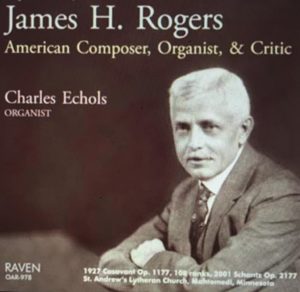James Hotchkiss Rogers
(1857–1940) may not be a household name today, but this Clevelander
was a nationally recognized figure in his day, both as a gifted organist and as a composer. In fact a dozen of his still popular compositions can be heard today on Youtube, some uploaded by more than one performer. Indeed, you’ll also find recordings there by two famed sopranos of yesteryear, Kirsten Flagstad and Geraldine Farrar, of a tender Rogers composition for voice and piano, “At Parting.” Others include his “Song of Triumph” (played on the largest organ in Finland); “Cloud-Shadows” (for voice and piano), the sprightly movement called “Elves” from his Opus 50, Wonderland Folks; all five movements of his Sonata in e minor for organ; a Toccatina for organ; and his widely performed arrangement for piano of Reginald de Koven’s classic wedding song, “Oh, Promise Me!” A recording of Rogers playing his own arrangement of “Forest Murmurs” from Wagner’s Siegfried is included on a Chandos album, The Orchestral Organ.
At age 18, he traveled to Europe to study with famed French organist/composers

Present-day organists still proudly upload their performances of Rogers’ compositions to Youtube.
Félix-Alexandre Guilmant (1837–1911) and Charles-Marie Jean Albert Widor (1844–1937), returning five years later to Cleveland, where he would serve as organist at the Euclid Avenue Baptist Church (which John D. Rockefeller attended) for 19 years, and, for 50 years, as organist and choir director at Euclid Avenue Temple, the first home of what became Anshe Chesed Fairmount Temple. Much in demand, he was also the First Unitarian Church’s organist for 35 years, taught at the Cleveland School of Music, and, served as the Plain Dealer’s music critic from 1915 until his retirement in 1932.
Meanwhile, he was hard at work composing—over 550 works by the time he was done including 50 compositions for organ like Song of Triumph still beloved by organists, as are his 10 Octave Studies and several charming pieces for piano such as Au Rouet (At the Spinning Wheel), Valse Reveuse (Dreamy Waltz) and The Development of Velocity; more than 130 songs; and five cantatas including The New Life, an Easter cantata, and Man of Nazareth, a Lenten cantata, the score of which now resides in Cleveland Public Library’s Special Collections. Music historian Heywood Alexander describes Rogers’s style of composition as late Romantic, tending toward the sentimental, but his work endures. He was a man who felt deeply. His six-song cycle In Memoriam, set to the poetry of Walt Whitman, was written for his son Henry, who was killed in World War I.
On his retirement, 500 musicians and friends gathered to honor Rogers at a farewell dinner; in 1946 the Cleveland Orchestra dedicated a program to him. He is buried in Lake View Cemetery. Cleveland composer and CWRU music librarian Jeffrey Quick is something of an authority on Charles Rogers. Cleveland Public Library has a large selection of his published music. Free scores by James Hotchkiss Rogers are available from the International Music Score Library Project (IMSLP). Several of his compositions, which are still popular with performers—can be heard on Youtube: